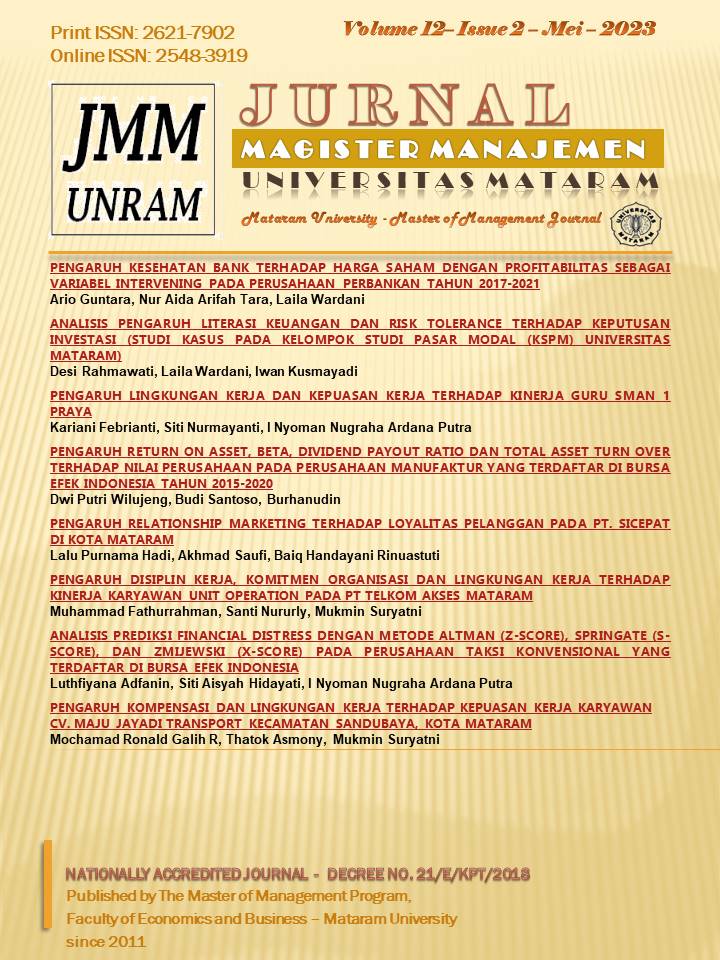ANALISIS PENGARUH LITERASI KEUANGAN DAN RISK TOLERANCE TERHADAP KEPUTUSAN INVESTASI (STUDI KASUS PADA KELOMPOK STUDI PASAR MODAL (KSPM) UNIVERSITAS MATARAM)
DOI:
https://doi.org/10.29303/jmm.v12i2.773Abstract
The purpose of this study is to find out the effect of financial literacy and risk tolerance on investment decisions of members of the Mataram University Capital Market Study Group (KSPM). The type of research used in this study is associative research. The data collection method used is a census method using primary data collected directly from respondents using questionnaires. The population in this study is all members of the Mataram University Capital Market Study Group (KSPM). The sample in this study was determined by a saturated sampling technique in which all 42 members of the population were sampled. The data analysis method used is the Partial Least Square (PLS) technique using the SmartPLS Partial Least Square (PLS) software application. The analysis results show that: (1) financial literacy has a positive and significant effect on investment decisions, and (2) risk tolerance has a positive but insignificant effect on investment decisions.References
Abdillah, W., & Hartono. (2021). Partial Least Square (PLS) Alternatif Structural Equation
Modeling (SEM) Dalam Penelitian Bisnis. (A. Offset (ed.)). P. D. J.
Al-Tamimi, H., & Anood, A. (2009). Financial literacy and investment decisions of UAE
investors. Journal of Risk Finance, 10(5), 500–516.
https://doi.org/10.1108/15265940911001402
Anggirani, N. (2017). Pengaruh Risk Tolerance, overconfidence, dan Literasi Keuangan
Terhadap Pengambilan Keputusan Investasi Masyarakat Surabaya.
Eprints.Perbanas.Ac.Id, 1–15.
Ateş, S., Coşkun, A., & Şahin, M. A. (2016). Impact of Financial Literacy on the Behavioral
Biases of Individual Stock Investors: Evidence from Borsa Istanbul. Business and
Economics Research Journal, 7(3), 1–1. https://doi.org/10.20409/berj.2016321805
Farida, B. (2022). Investor di NTB Bertambah, Transaksi Pasar Modal Capai Rp 1,7 Triliun.
Lombok Post. https://lombokpost.jawapos.com/ekonomi-
bisnis/27/05/2022/investor-di-ntb-bertambah-transaksi-pasar-modal-capai-rp-17-
triliun/
Ghozali, I. (2015). Structural Equation Modeling Metode Alternatif Dengan Partial Least Square
(PLS). Badan Penerbit Universitas Diponogoro.
Hakim, L. (2010). Simultan Risk dan Return (1st ed.). CV. Pena Persada Redaksi.
Hanna, S., Gutter, M., & Fan, J. (2001). A theory based measure of risk tolerance. Proceedings
of the Academy of Financial Services, 10–11.
Khairiyati, C. (2019). ANALISIS PENGARUH LITERASI KEUANGAN TERHADAP
KEPUTUSAN INVESTASI PADA MASYARAKAT KOTA BANDUNG. Manajemen
Dan Bisnis, 3.
Lusardi, A., Mitchell, O. S., & Curto, V. (2009). Financial Literacy Among the Young:
Evidence and Implications For Cunsumer Policy. National Bureau of Economic
Research, 358–380. https://www.nber.org/papers/w15352.pdf
Masdupi, E., & Tasman, A. (2014). DASAR-DASAR KEBIJAKAN INVESTASI DAN
KEBIJAKAN DEVIDEN (S. Jumiatti (ed.)). Sabina Press.
OJK. (2022). Survei Nasional Literasi dan Inklusi Keuangan 2022. Otoritas Jasa Keuangan
(OJK). https://www.ojk.go.id/id/berita-dan-kegiatan/info-
terkini/Pages/Infografis-Survei-Nasional-Literasi-dan-Inklusi-Keuangan-Tahun-
aspx
Pak, O., & Mahmood, M. (2015). Impact of personality on risk tolerance and investment
decisions: A study on potential investors of Kazakhstan. International Journal of
Commerce and Management, 25(4), 370–384. https://doi.org/10.1108/IJCoMA-01-
-0002
Rasuma Putri, N. M. D., & Rahyuda, H. (2017). Pengaruh Tingkat Financial Literacy Dan
Faktor Sosiodemografi Terhadap Perilaku Keputusan Investasi Individu. E-Jurnal
Ekonomi Dan Bisnis Universitas Udayana, 9, 3407.
https://doi.org/10.24843/eeb.2017.v06.i09.p09
Sugiyono. (2010). Metode Penelitian Kuantitatif Kualitatif dan R&D. Intro. In Bandung Alf
(10th ed.). ALFABETA.
Yasa, W., Upadana, A., & Trisna Herawati, N. (2020). Pengaruh Literasi Keuangan dan
Perilaku Keuangan terhadap Keputusan Investasi Mahasiswa. Jurnal Ilmiah
Akuntansi Dan Humanika, 10(2).
Downloads
Published
How to Cite
Issue
Section
License
Copyright (c) 2023 Desi Rahmawati, Laila Wardani, Iwan Kusmayadi

This work is licensed under a Creative Commons Attribution 4.0 International License.
- Authors retain copyright and grant the journal right of first publication with the work simultaneously licensed under a CC BY 4.0. This license allows authors to use all articles, data sets, graphics, and appendices in data mining applications, search engines, web sites, blogs, and other platforms by providing an appropriate reference. The journal allows the author(s) to hold the copyright without restrictions and will retain publishing rights without restrictions.
- Authors are able to enter into separate, additional contractual arrangements for the non-exclusive distribution of the journal's published version of the work (e.g., post it to an institutional repository or publish it in a book), with an acknowledgment of its initial publication in JMM.
- Authors are permitted and encouraged to post their work online (e.g., in institutional repositories or on their website) prior to and during the submission process, as it can lead to productive exchanges, as well as earlier and greater citation of published work (See The Effect of Open Access).










